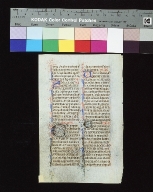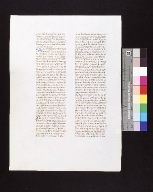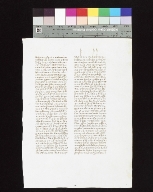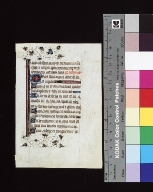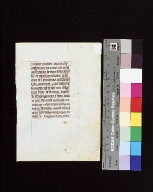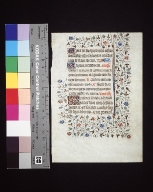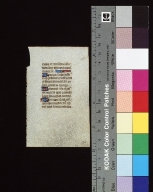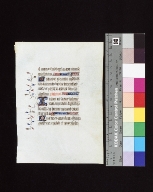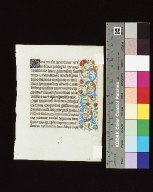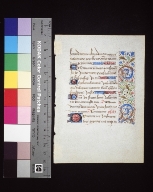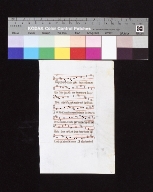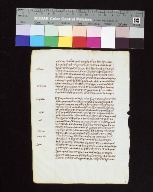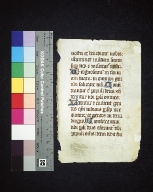|
REFINE
Browse All : Illumination of books and manuscripts, Medieval of France
1-17 of 17
Title
Biblia sacra Latina, versio vulgata: fragment
Summary
[Ms. This manuscript leaf is part of a collection of medieval manuscript leaves selected to illustrate the art of the manuscript during the period of its greatest development and influence. They have been taken from books written in various European scriptoria by Benedictine, Franciscan, Carthusian, Dominican, and other orders of monks. Many are enriched with handsome borders, initial letters, and line-endings rendered in color. Twenty-five are illuminated with burnished gold or silver. The texts include the Bible, various church service books, the writings of the Church fathers, and some of the Classics., In angular gothic script, This copy of the Latin version by St. Jerome was made during the period when France stood at the height of her medieval glory. A decade or two before, Louis IX (Saint Louis), the strongest monarch of his age, had made France the mightiest power in Europe. This favorable political situation rendered possible the "golden age" of the manuscript, and Paris became the center in which the finest manuscripts were written and sold. In the quarter century from 1275 to 1300, marked advances were effected in the art. The bar borders came to be executed in rich opaque gouache pigments, with ultramarine made of powdered lapis lazuli predominating. The foliage scroll work inside the initial frame created a style that persisted with little or no change for nearly two hundred years. The script was well executed and was without rigidity or tension. All these elements, together with the sparkle which was created by the casual distribution of the burnished gold accents, give to this leaf a striking atmosphere of joyous freedom. This vellum leaf was created in France.]
Title
Breviarium: fragment
Creator
Catholic Church
Summary
[Ms. This manuscript leaf is part of a collection of medieval manuscript leaves selected to illustrate the art of the manuscript during the period of its greatest development and influence. They have been taken from books written in various European scriptoria by Benedictine, Franciscan, Carthusian, Dominican, and other orders of monks. Many are enriched with handsome borders, initial letters, and line-endings rendered in color. Twenty-five are illuminated with burnished gold or silver. The texts include the Bible, various church service books, the writings of the Church fathers, and some of the Classics., In angular gothic script, In the middle of the 14th century many of the manuscripts show influences from other countries. Illuminators, scribes, and other craftsmen traveled from city to city and even from country to country. While the script of this leaf is almost certainly French, the initial letters and filigree decoration might easily be of Italian workmanship, and the greenish tone of the ink suggests English manufacture. The dorsal motif in the bar ornament is again decidedly French, and the lemon tone of the gold is a third indication of French origin. In England, the burnished gold elements are generally of an orange tint, due to the presence of an alloy; in Italy, they are a rosy color because the underlying gesso or plaster base was mixed with a red pigment. This vellum leaf was created in France.]
Title
Breviarium: fragment
Creator
Catholic Church
Summary
[Ms. This manuscript leaf is part of a collection of medieval manuscript leaves selected to illustrate the art of the manuscript during the period of its greatest development and influence. They have been taken from books written in various European scriptoria by Benedictine, Franciscan, Carthusian, Dominican, and other orders of monks. Many are enriched with handsome borders, initial letters, and line-endings rendered in color. Twenty-five are illuminated with burnished gold or silver. The texts include the Bible, various church service books, the writings of the Church fathers, and some of the Classics., In script, Breviaries were seldom owned by laymen. They were service books and contained the Psalter with the versicles, responses, collects and lections for Sundays, weekdays, and saints' days. Other texts could be included. A Breviary, therefore, was lengthy and usually bulky in format. Miniature copies like the one represented by this leaf are rare. The angular gothic script required a skilled calligrapher. It would be difficult for a modern engrosser to match, even with steel pens, the exactness and sharpness of these letters formed with a quill by a 13th century scribe. Green was a decorative color added to the palette in the late 13th century in many scriptoria. The medieval formulae for making it from earth, flowers, berries, and metals are often elaborate and strange. This manuscript was written on fine uterine vellum, i.e., the skin of an unborn calf. It evidently had hard use, or may have been buried with its owner. This vellum leaf was created in France.]
Title
Breviarium: fragment
Creator
Catholic Church
Summary
[Ms. This manuscript leaf is part of a collection of medieval manuscript leaves selected to illustrate the art of the manuscript during the period of its greatest development and influence. They have been taken from books written in various European scriptoria by Benedictine, Franciscan, Carthusian, Dominican, and other orders of monks. Many are enriched with handsome borders, initial letters, and line-endings rendered in color. Twenty-five are illuminated with burnished gold or silver. The texts include the Bible, various church service books, the writings of the Church fathers, and some of the Classics., In angular gothic script, The Breviary is one of the six official books used by the Roman Catholic Church in its liturgy. It is a book of prayer for the clergy, giving the directions for all of the various services of the Divine Hours throughout the year. The other five official books are the Pontifical, the Missal, the Ritual, the Martyrology, and the Ceremonial of the Bishops. The angular script in this leaf is executed with great skill and precision. The small and vigorous black initials and the hair line details found in many of the ascenders and terminal letters indicate the work of a superior calligrapher, skilled not only in writing but also in sharpening his quill. The initials and the dorsal decorations also represent the same high standard of craftsmanship. Strangely, the rubrications do not show as great a calligraphic skill. Usually it was the task of a superior scribe to insert the rubrics or directions for conducting the service. This vellum leaf was created in France.]
Title
Contra Jovinianum: fragment
Creator
Jerome, Saint, d. 419 or 20
Summary
[Ms. This manuscript leaf is part of a collection of medieval manuscript leaves selected to illustrate the art of the manuscript during the period of its greatest development and influence. They have been taken from books written in various European scriptoria by Benedictine, Franciscan, Carthusian, Dominican, and other orders of monks. Many are enriched with handsome borders, initial letters, and line-endings rendered in color. Twenty-five are illuminated with burnished gold or silver. The texts include the Bible, various church service books, the writings of the Church fathers, and some of the Classics., In letter de somme, Jerome, the father of the Latin Church and translator of the Bible, shows in his writing his active participation in the controversies of his day (c. 332 to 420 A.D.). With the frequent use of vehement invective, he is often as biting as Juvenal or Martial. This fine book hand, lettre de somme, obtained its name from the fact that Fust and Schoeffer used a type based on it for the printing of their Summa Theologica of St. Thomas Aquinas in 1467. It was the favorite manuscript book hand in the second half of the 15th century for the transcribing of French chronicles and romances. Simplicity and dignity are maintained by omitting all enrichment around the burnished gold letters. The first printed books followed the practice seen here of marking off by hand and with a stroke of red the capitals at the beginning of each sentence. Fifteenth century ink frequently had a tendency to fade to a gray tone as in this example. This vellum leaf was created in France.]
Title
Dialogi: fragment
Creator
Gregory I, Pope, approximately 540-604
Summary
[Ms. This manuscript leaf is part of a collection of medieval manuscript leaves selected to illustrate the art of the manuscript during the period of its greatest development and influence. They have been taken from books written in various European scriptoria by Benedictine, Franciscan, Carthusian, Dominican, and other orders of monks. Many are enriched with handsome borders, initial letters, and line-endings rendered in color. Twenty-five are illuminated with burnished gold or silver. The text includes the Bible, various church service books, the writings of the Church fathers, and some of the Classic., In letter bátarde script, This composite text includes the Dialogues of Pope Gregory I (St. Gregory the Great, 540-604 A.D.), which are largely autobiographical, and his writing on the lives and miracles of the early Italian Church Fathers. The book hand used is known as letter bátarde, a semi-cursive hand closely related to the everyday writing used by the people. Many French and Flemish printing types were based on similar bátarde hands. The writing was done with comparative speed; the even tone and the exact alignment of the right hand margin, as well as the beauty of individual letters, are admirable. The long ascenders in the upper line were borrowed from the legal documents of the day. Many printers followed the practice shown here of emphasizing the tone of the first word or two in the beginning of a paragraph. It was usually done without varying the style of the letters, while here we see angular gothic used in the first third of the line, followed by the bátarde script. This vellum leaf was created in late fifteenth-century France.]
Title
Horae Beatae Mariae Virginis: fragment
Creator
Catholic Church
Summary
[Ms. This manuscript leaf is part of a collection of medieval manuscript leaves selected to illustrate the art of the manuscript during the period of its greatest development and influence. They have been taken from books written in various European scriptoria by Benedictine, Franciscan, Carthusian, Dominican, and other orders of monks. Many are enriched with handsome borders, initial letters, and line-endings rendered in color. Twenty-five are illuminated with burnished gold or silver. The texts include the Bible, various church service books, the writings of the Church fathers, and some of the Classics., In angular gothic script, This Book of Hours shows definite characteristics of the manuscript art of France and the Netherlands of about 1450 A.D. It was probably one of many copies prepared for sale at a shrine to which devout pilgrims came to worship or to seek a cure. The spiked letters and the detached ornamental bar are unmistakably Flemish in spirit, while the free ivy sprays are distinctively French. The burnished metal in the decorations shows the use of alloyed gold (oro di metà) as well as silver. Various metals were added in different localities to the fine gold. English illuminations frequently had a decided orange hue, while the French had a lemon cast. The quality of the gold was best enhanced by the use of burnishing tools equipped with an emerald, a topaz, or a ruby. Less successful burnishers contained an agate or the tooth of a wolf, a horse, or a dog. This vellum leaf was created in Northern France.]
Title
Horae Beatae Mariae Virginis: fragment
Creator
Catholic Church
Summary
[Ms. This manuscript leaf is part of a collection of medieval manuscript leaves selected to illustrate the art of the manuscript during the period of its greatest development and influence. They have been taken from books written in various European scriptoria by Benedictine, Franciscan, Carthusian, Dominican, and other orders of monks. Many are enriched with handsome borders, initial letters, and line-endings rendered in color. Twenty-five are illuminated with burnished gold or silver. The texts include the Bible, various church service books, the writings of the Church fathers, and some of the Classics., In angular gothic script, It is generally no great task to assign these illuminated Books of Hours to a particular country or period. The treatment of the ivy spray with the single line stem and rather sparse foliage is characteristic of the work of the French monastic scribes about the year 1450 A.D. The occasional appearance of the strawberry indicates that the illuminating was done by a Benedictine monk. Fifty years earlier the stem would have been wider and colored, and the foliage rich; fifty years later the ivy and holly leaves would be entangled with flowers and acanthus foliage. This vellum leaf was created in France.]
Title
Horae Beatae Mariae Virginis: fragment
Creator
Catholic Church
Summary
[Ms. This manuscript leaf is part of a collection of medieval manuscript leaves selected to illustrate the art of the manuscript during the period of its greatest development and influence. They have been taken from books written in various European scriptoria by Benedictine, Franciscan, Carthusian, Dominican, and other orders of monks. Many are enriched with handsome borders, initial letters, and line-endings rendered in color. Twenty-five are illuminated with burnished gold or silver. The texts include the Bible, various church service books, the writings of the Church fathers, and some of the Classics., In angular gothic script, The text of a Book of Hours consists of Gospels of the Nativity, prayers for the Canonical Hours, the Penitential Psalms, the Litany, and other prayers. The beauty of the rich borders found in some of these books frequently claims our attention more than the text. In these borders it is easy to recognize the ivy leaf and the holly, but is usually more difficult to identify the daisy, thistle, cornbottle, and wild stock. The monks had no hesitancy in letting these flowers grow from a common stem. Because of the translucency of vellum, the flowers, stems, and leaves of the border were carefully superimposed on the reverse side in order to avoid a blurred effect. This vellum leaf was created in France.]
Title
Horae Beatae Mariae Virginis: fragment
Creator
Catholic Church
Summary
[Ms. This manuscript leaf is part of a collection of medieval manuscript leaves selected to illustrate the art of the manuscript during the period of its greatest development and influence. They have been taken from books written in various European scriptoria by Benedictine, Franciscan, Carthusian, Dominican, and other orders of monks. Many are enriched with handsome borders, initial letters, and line-endings rendered in color. Twenty-five are illuminated with burnished gold or silver. The texts include the Bible, various church service books, the writings of the Church fathers, and some of the Classics., In angular gothic script, Books of Hours, beautifully written, enriched with burnished gold initials, and adorned with miniature paintings, were frequently the most treasured possessions of the devout and wealthy layman. They were not only carried to chapel but were often kept at the bedside at night. Oaths were sworn on them. Books of this small size, two and one-half by three and one-half inches, are comparatively rare. The craftsmanship in this example imitates and equals that in a volume of ordinary size, about five by seven inches. Recently these small "pocket" editions have been given the nickname "baby manuscripts." In general, the miniature Books of Hours contain only that section of the complete volume which deals with the prayers to be read or recited at the canonical hours; namely, matins, vespers, nocturns, and those for the prime, tierce, sext, nones, and complin. Indulgences were often granted for the faithful reading or recitation of these prayers. This vellum leaf was created in France.]
Title
Horae Beatae Mariae Virginis: fragment
Creator
Catholic Church
Summary
[Ms. This manuscript leaf is part of a collection of medieval manuscript leaves selected to illustrate the art of the manuscript during the period of its greatest development and influence. They have been taken from books written in various European scriptoria by Benedictine, Franciscan, Carthusian, Dominican, and other orders of monks. Many are enriched with handsome borders, initial letters, and line-endings rendered in color. Twenty-five are illuminated with burnished gold or silver. The texts include the Bible, various church service books, the writings of the Church fathers, and some of the Classics., In gothic script, This manuscript leaf came from a Book of Hours, sold probably at one of the famous shrines to which wealthy laymen made pilgrimages. To meet the demand for these books, the monastic as well as the secular scribes produced them in great numbers. The freely drawn, indefinite buds here entirely supplant the ivy, fruits, and realistic wayside flowers which characterized the borders of manuscripts of the preceding half century. The initial letters of burnished gold on a background of old rose and blue with delicate white line decorations maintain the tradition of the earlier period. The vellum is of silk-like quality that often distinguished the manuscripts of France and Italy.]
Title
Horae Beatae Mariae Virginis: fragment
Creator
Catholic Church
Summary
[Ms. This manuscript leaf is part of a collection of medieval manuscript leaves selected to illustrate the art of the manuscript during the period of its greatest development and influence. They have been taken from books written in various European scriptoria by Benedictine, Franciscan, Carthusian, Dominican, and other orders of monks. Many are enriched with handsome borders, initial letters, and line-endings rendered in color. Twenty-five are illuminated with burnished gold or silver. The texts include the Bible, various church service books, the writings of the Church fathers, and some of the Classics., In gothic script, The Book of Hours, the prayer book of laity, usually contains 16 sections. The section on prayers to the Virgin is the most important and most used, and its manuscripts exceed in number all other 15th century religious texts. The laymen who ordered and purchased these books would at times stipulate the style of ornament and the amount of burnished gold to be used, and could even, to a certain extent, select the saints they esteemed most and wished to glorify. In this example, the border reveals by its wayside flowers entangled with the heavy acanthus motif of the North and by the use of "wash" gold that it was executed in Northern France about 1475 A.D.]
Title
Horae Beatae Mariae Virginis: fragment
Creator
Catholic Church
Summary
[Ms. This manuscript leaf is part of a collection of medieval manuscript leaves selected to illustrate the art of the manuscript during the period of its greatest development and influence. They have been taken from books written in various European scriptoria by Benedictine, Franciscan, Carthusian, Dominican, and other orders of monks. Many are enriched with handsome borders, initial letters, and line-endings rendered in color. Twenty-five are illuminated with burnished gold or silver. The texts include the Bible, various church service books, the writings of the Church fathers, and some of the Classics., In cursive gothic script, This beautiful manuscript leaf was written and illuminated about the year 1535 A.D. At this late date Books of Hours were also being printed in great numbers by such famous French printers as Vostre, de Colines, and Tory. These were elaborately illustrated and frequenly hand-colored. The cursive gothic script used in this leaf, with its boldly accented letters and flourished initials, borrowed heavily from the decorative chancery or legal hands of the 13th and 14th centuries. It influenced the type face known as civilité, designed by Granjon, and first used in 1559 A.D. This vellum leaf was created in France.]
Title
Horae Beatae Mariae Virginis: fragment
Summary
[Ms. This manuscript leaf is part of a collection of medieval manuscript leaves selected to illustrate the art of the manuscript during the period of its greatest development and influence. They have been taken from books written in various European scriptoria by Benedictine, Franciscan, Carthusian, Dominican, and other orders of monks. Many are enriched with handsome borders, initial letters, and line-endings rendered in color. Twenty-five are illuminated with burnished gold or silver. The texts include the Bible, various church service books, the writings of the Church fathers, and some of the Classics., In angular gothic script, In the second half of the 15th century, the devout and wealthy laymen had a wide selection of Books of Hours from which to choose, both manuscript volumes and printed texts. These were often sold, in large cities, in book stalls erected directly in front of the main entrance to the cathedral. The first printed and illustrated Book of Hours appeared in 1486. It was a crude work, but later noted printers such as Verard, Du Pre, Pigouchet, and Kerver issued in great numbers Books of Hours with numerous illustrations and rich borders. The decorations were frequently hand colored and further embellished with touches of gold. These Books of Hours created a strong competition for the more costly manuscript copies. Customers who still preferred the manuscript format and could afford it also had a choice of many different types of decoration and could stipulate what quantity and quality of miniatures they desired. By this time the ivy spray had a variety of forms. It might be seen springing from an initial letter, from the end of a detached bar, in a separate panel in company with realistic flowers, or forming a three- or four-sided border intermixed with acanthus leaves and even birds, animals, and hybrid monsters which are neither man nor beast. This vellum leaf was created in France.]
Title
Hymnarium: fragment
Summary
[Ms. This manuscript leaf is part of a collection of medieval manuscript leaves selected to illustrate the art of the manuscript during the period of its greatest development and influence. They have been taken from books written in various European scriptoria by Benedictine, Franciscan, Carthusian, Dominican, and other orders of monks. Many are enriched with handsome borders, initial letters, and line-endings rendered in color. Twenty-five are illuminated with burnished gold or silver. The texts include the Bible, various church service books, the writings of the Church fathers, and some of the Classics., In angular gothic script; Gregorian notation., At important festival services such as Christmas and Easter these small hymnals were generally used by the laymen as they walked in procession to the various altars. Much of the material incorporated in the hymnals was based on folk melodies. Hymns, like the other chants of the Church, varied according to their place in the liturgy. Their melodies are frequently distinguished by a refrain which was sung at the beginning and at the end of each stanza. The initial letter design of this leaf persisted with little or no change for a long period, but the simple pendant spear was used as a distinctive motif for not more than twenty-five years. This leaf was created in France.]
Title
Psalter. Fragments.
Creator
Catholic Church
Summary
[Ms. This manuscript leaf is part of a collection of medieval manuscript leaves selected to illustrate the art of the manuscript during the period of its greatest development and influence. They have been taken from books written in various European scriptoria by Benedictine, Franciscan, Carthusian, Dominican, and other orders of monks. Many are enriched with handsome borders, initial letters, and line-endings rendered in color. Twenty-five are illuminated with burnished gold or silver. The texts include the Bible, various church service books, the writings of the Church fathers, and some of the Classics., In carolingian minuscule script, This text is from a special arrangment of the Psalms. Several Church Fathers made their own groupings for the Scriptures. Of these so-called "chains" the most famous is that of St. Thomas Aquinas. The author of the arrangement represented by this leaf is unknown. The scribe of the 12th century often came close to achieving perfection. The symmetry of his letters, the unerring accuracy of his practiced hand, and his ideals for letter forms have rarely been equaled and have never been surpassed. The words which were inserted in the margin are not corrections but were added as guides to the content of the page. This vellum leaf was created in France.]
Title
Psalterium: fragment
Creator
Catholic Church
Summary
[Ms. This manuscript leaf is part of a collection of medieval manuscript leaves selected to illustrate the art of the manuscript during the period of its greatest development and influence. They have been taken from books written in various European scriptoria by Benedictine, Franciscan, Carthusian, Dominican, and other orders of monks. Many are enriched with handsome borders, initial letters, and line-endings rendered in color. Twenty-five are illuminated with burnished gold or silver. The texts include the Bible, various church service books, the writings of the Church fathers, and some of the Classics., In gothic script, The psalter with its one hundred and fifty psalms is the best collection of religious lyrics which the world possesses. It is no wonder, therefore, that it forms an important part of so many medieval manuscripts. The Psalms are found not only in manuscripts of the bible, but also in Missals, Breviaries, and Books of Hours; and, as they had to be memorized by the priests, they were also transcribed separately. In the earlier periods there was generally a harmonious unity between the spirit of the ornament and the character of the writing. This unity is exemplified in this leaf. The three lobed, gracefully drawn symmetrical fronds of leaves in the ornament are usually accepted without question as representing the ivy plant. In the Middle Ages many magical and medicinal qualities were attributed to this plant. Unfortunately, fire and water, mice and men have in the course of the centuries often left their damaging marks on manuscript leaves. Some pages of this manuscript book show the effect of having been exposed to dampness. This vellum leaf was created in France.]
1-17 of 17
|

